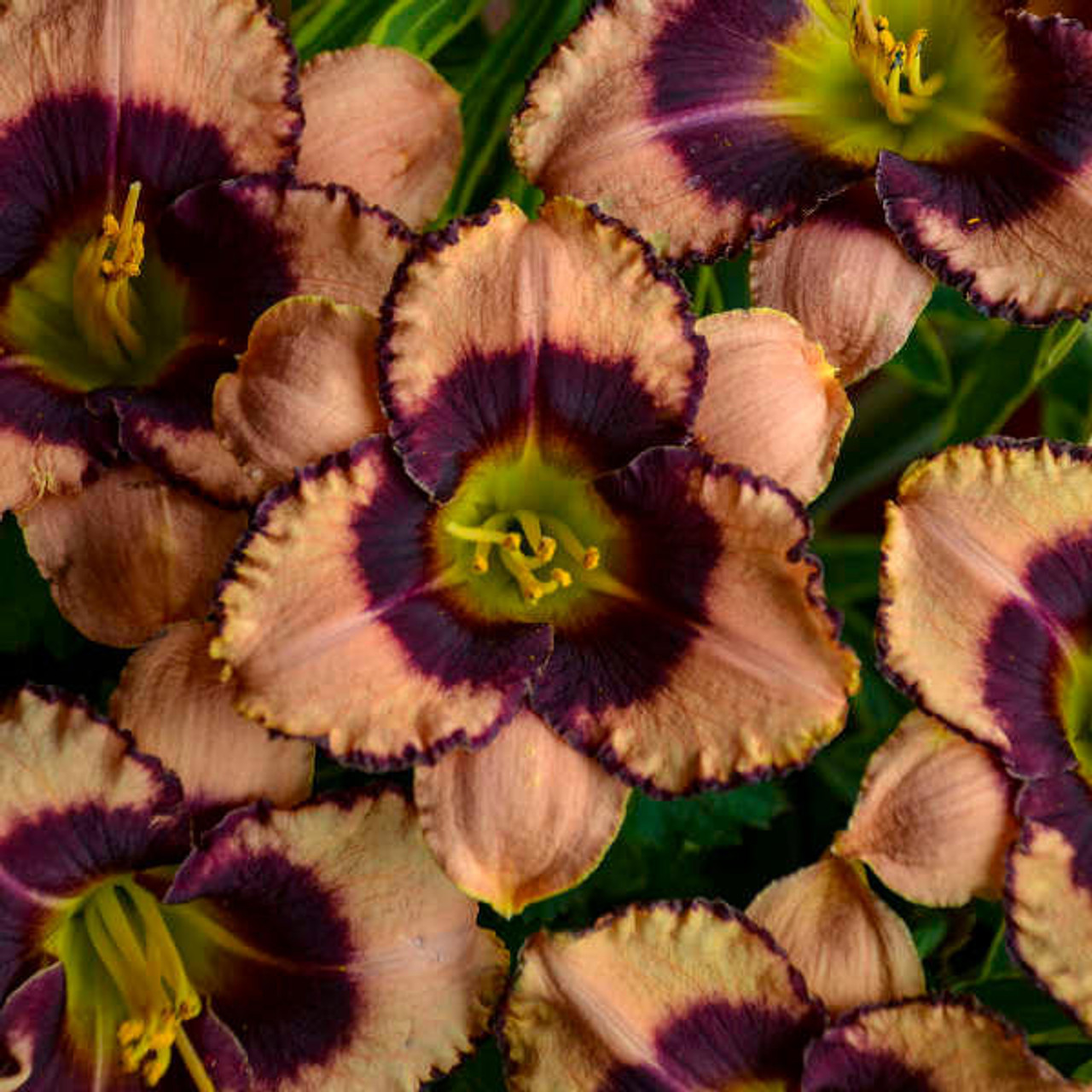Product Description
Hemerocallis 'Daring Deception' Daylily (Salter 1994) (25) bare root clumps
- 5.5", dusty cream-pink self with a large, dark purple eye and green throat
- Petals overlap, creating a uniquely shaped eyezone
- Petals have dark purple picotee, pie crust edges; sepals have smooth borders
- Semi-evergreen foliage
- Blooms from early to mid-summer; rebloomer
- Tetraploid
Height: 24 Inches
Spread: 18 - 24 inches
Hardiness Zones: 3,4,5,6,7,8,9
Flower Color: Pink shades
Full Sun (> 6 hrs. Direct Sun) to Part Shade (4-6 hrs. Direct Sun)
Low to Average Water Needs
Poor to Fertile Soil Quality
Bloomtime: Early Summer, Midsummer, Rebloomer
Attracts Butterflies and Hummingbirds
Bee Friendly
Rabbit Resistant
Growth Rate: Medium
Border Plant, Mass Planting, Easy To Grow, Salt Tolerant
Embrace a Double Dose of Beauty with 'Daring Deception' Daylily!
Hemerocallis 'Daring Deception' is a captivating reblooming daylily that offers a delightful surprise with its unique color pattern and extended flowering period. This enchanting perennial boasts pale lavender-pink petals adorned with a bold, dark purple eyezone, creating a stunning contrast that will mesmerize any onlooker.
'Daring Deception' is a standout daylily that defies expectations with its captivating beauty and reblooming nature. The large, 5-inch flowers display a delicate pale lavender-pink base color, which is dramatically offset by a large, dark purple eyezone surrounding a vibrant green throat. The petals have a subtle ruffled edge, adding a touch of elegance. This daylily blooms in early mid-summer and then graces the garden with a second flush of blooms later in the season, extending its appeal. The foliage is a healthy green, forming an attractive clump that complements the stunning flowers.
- Mature Size: 24 inches tall, 18-24 inches wide
- Flower Color: Pale lavender-pink with a dark purple eyezone and green throat
- Bloom Time: Early mid-summer, reblooming later in the season
- Foliage: Green, arching, strap-like
- Growth Habit: Clump-forming, upright
- Light Needs: Full sun to part shade (at least 6 hours of sun for best blooming)
- Soil Needs: Well-drained soil; adaptable to various soil types
- Hardiness Zones: 3-9 (USDA)
- Special Features: Reblooming, showy flowers, unique color pattern, attracts butterflies
Planting:
- Timing: Plant in spring or fall for best results.
- Location: Choose a sunny to partially shaded spot with well-drained soil. Daylilies thrive in locations that receive at least 6 hours of sunlight.
- Soil Preparation: Amend the soil with compost or other organic matter to improve drainage and fertility.
- Spacing: Space plants 18-24 inches apart to allow for adequate growth.
- Planting Depth: Plant the crown (where the roots meet the foliage) at the same depth as it was in the container.
- Watering: Water thoroughly after planting and regularly until it is established.
Care:
- Watering: Once established, 'Daring Deception' is relatively drought-tolerant, but it will bloom best with consistent moisture. Water deeply during prolonged dry spells.
- Fertilizing: Apply a balanced fertilizer in early spring to promote vigorous growth and abundant blooming.
- Deadheading: Removing spent flowers (deadheading) can improve the plant's appearance and encourage reblooming.
- Dividing: Divide clumps every 3-5 years to prevent overcrowding and rejuvenate the plant. This is best done in spring or fall.
- Pest and Disease Control: 'Daring Deception' is generally pest and disease resistant.
Uses in the Garden:
- Borders and Edging: Adds a captivating touch of color to borders and edges.
- Mass Plantings: Plant in groups for a stunning display of unique blooms.
- Containers: Can be grown in large containers, adding a beautiful focal point to patios and balconies.
- Mixed Borders: Combines beautifully with other perennials and shrubs.
- Focal Point: The eye-catching color pattern makes it a great focal point in the garden.
Experience the double delight of 'Daring Deception' with its reblooming beauty and captivating color!
Other Details
The most important part of the plant is its root system. Healthy roots are the foundation of a healthy, vibrant plant. The type of plug container used is based on the specific needs of the plants. Perennials offered as bare root traditionally perform better when planted as bare root.Planted in a specialized mix, potted plants have well established root systems. Top growth stage will vary depending on the current life cycle and time of year when shipped. In Winter and early Spring dormant plants may be shipped. Dormant plants may be planted right away, even before the last frost date.
Most bare root varieties are field grown for at least one season, though Hemerocallis and Hosta are grown for two seasons. The bulk of the soil is removed during the harvesting process and the tops of most varieties are trimmed back to the crown. They are graded, packed in shredded aspen or sphagnum moss and stored in freezers until ready to be shipped.
See our Container Sizes and Bare Root Perennials pages for more information.
Plant information and care is provided in the Overview section, Plant Genus Page and general information is provided in the Planting Care & Guides. Additional questions can be asked on each Plant page.
Plant Spacing: Using the maximum mature spread or width of a plant to guide spacing, ensures space to grow to full size. To fill an area sooner, plant them closer together. Just remember, future thinning or transplanting may be needed.
Water: Keep a close eye on newly planted perennials, especially throughout the first growing year. Most early plant loss is due to too much or too little water!



















